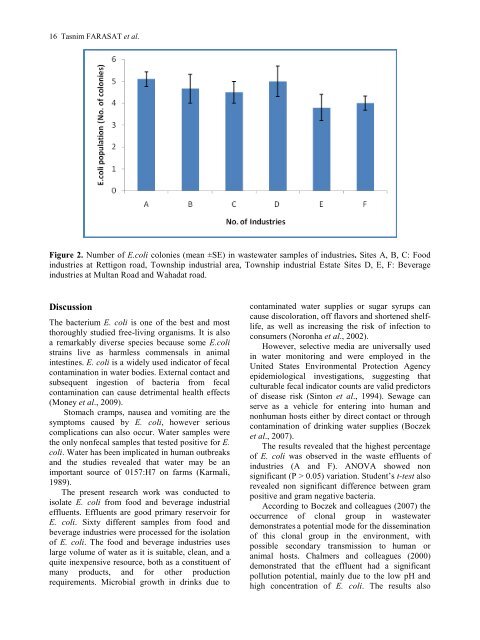10 1 Full Volume (PDF)(jcmb.halic.edu.tr) - Journal of Cell and ...
10 1 Full Volume (PDF)(jcmb.halic.edu.tr) - Journal of Cell and ...
10 1 Full Volume (PDF)(jcmb.halic.edu.tr) - Journal of Cell and ...
You also want an ePaper? Increase the reach of your titles
YUMPU automatically turns print PDFs into web optimized ePapers that Google loves.
16 Tasnim FARASAT et al.<br />
Figure 2. Number <strong>of</strong> E.coli colonies (mean ±SE) in wastewater samples <strong>of</strong> indus<strong>tr</strong>ies. Sites A, B, C: Food<br />
indus<strong>tr</strong>ies at Rettigon road, Township indus<strong>tr</strong>ial area, Township indus<strong>tr</strong>ial Estate Sites D, E, F: Beverage<br />
indus<strong>tr</strong>ies at Multan Road <strong>and</strong> Wahadat road.<br />
Discussion<br />
The bacterium E. coli is one <strong>of</strong> the best <strong>and</strong> most<br />
thoroughly studied free-living organisms. It is also<br />
a remarkably diverse species because some E.coli<br />
s<strong>tr</strong>ains live as harmless commensals in animal<br />
intestines. E. coli is a widely used indicator <strong>of</strong> fecal<br />
contamination in water bodies. External contact <strong>and</strong><br />
subsequent ingestion <strong>of</strong> bacteria from fecal<br />
contamination can cause de<strong>tr</strong>imental health effects<br />
(Money et al., 2009).<br />
Stomach cramps, nausea <strong>and</strong> vomiting are the<br />
symptoms caused by E. coli, however serious<br />
complications can also occur. Water samples were<br />
the only nonfecal samples that tested positive for E.<br />
coli. Water has been implicated in human outbreaks<br />
<strong>and</strong> the studies revealed that water may be an<br />
important source <strong>of</strong> 0157:H7 on farms (Karmali,<br />
1989).<br />
The present research work was conducted to<br />
isolate E. coli from food <strong>and</strong> beverage indus<strong>tr</strong>ial<br />
effluents. Effluents are good primary reservoir for<br />
E. coli. Sixty different samples from food <strong>and</strong><br />
beverage indus<strong>tr</strong>ies were processed for the isolation<br />
<strong>of</strong> E. coli. The food <strong>and</strong> beverage indus<strong>tr</strong>ies uses<br />
large volume <strong>of</strong> water as it is suitable, clean, <strong>and</strong> a<br />
quite inexpensive resource, both as a constituent <strong>of</strong><br />
many products, <strong>and</strong> for other production<br />
requirements. Microbial growth in drinks due to<br />
contaminated water supplies or sugar syrups can<br />
cause discoloration, <strong>of</strong>f flavors <strong>and</strong> shortened shelflife,<br />
as well as increasing the risk <strong>of</strong> infection to<br />
consumers (Noronha et al., 2002).<br />
However, selective media are universally used<br />
in water monitoring <strong>and</strong> were employed in the<br />
United States Environmental Protection Agency<br />
epidemiological investigations, suggesting that<br />
culturable fecal indicator counts are valid predictors<br />
<strong>of</strong> disease risk (Sinton et al., 1994). Sewage can<br />
serve as a vehicle for entering into human <strong>and</strong><br />
nonhuman hosts either by direct contact or through<br />
contamination <strong>of</strong> drinking water supplies (Boczek<br />
et al., 2007).<br />
The results revealed that the highest percentage<br />
<strong>of</strong> E. coli was observed in the waste effluents <strong>of</strong><br />
indus<strong>tr</strong>ies (A <strong>and</strong> F). ANOVA showed non<br />
significant (P > 0.05) variation. Student’s t-test also<br />
revealed non significant difference between gram<br />
positive <strong>and</strong> gram negative bacteria.<br />
According to Boczek <strong>and</strong> colleagues (2007) the<br />
occurrence <strong>of</strong> clonal group in wastewater<br />
demons<strong>tr</strong>ates a potential mode for the dissemination<br />
<strong>of</strong> this clonal group in the environment, with<br />
possible secondary <strong>tr</strong>ansmission to human or<br />
animal hosts. Chalmers <strong>and</strong> colleagues (2000)<br />
demons<strong>tr</strong>ated that the effluent had a significant<br />
pollution potential, mainly due to the low pH <strong>and</strong><br />
high concen<strong>tr</strong>ation <strong>of</strong> E. coli. The results also
















